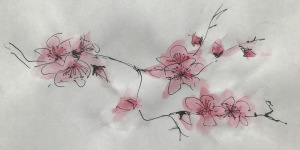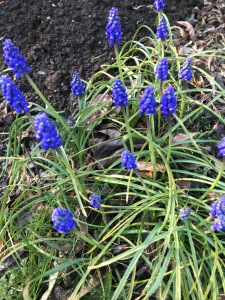
This morning I strolled through my smiling garden. The weather was perfect. Who could possibly feel gloomy when surrounded on all sides by spring flowers? Daffodils, crocuses, hyacinths, hellebores are all blooming their hearts out. The whispering buds of the cherry blossom are now caroling pink at eighty decibels or more.

A sudden, lush vitality seems to have sprung into being over night. So much robust vigor should offer comfort and hope; be a sign of resilience. Instead, all I see is fragility and impermanence. As I glance around, here and there the petals of earlier blooms flute and fall, my eye catching them in that indeterminable space where life crosses to death, the mysterious moment when matter becomes to heavy to bear. There is, too, a wider sense of the world beyond the garden, of the earth folding into itself rather than awakening. Climate change, Covid 19, escalating racism, looming recession, the decline of democracy – all speak not of joyous beginnings but of the end of times.

The government meanwhile seems determined to return our lives to ‘normal’ but what is normal when our bodies and minds have been irrevocably changed, when our safety and security are no longer guaranteed? At first, many of us experienced lockdown as an opportunity to rethink our life on earth. To consider possibilities beyond such human constructs as the ‘economy.’ But as time has gone on, Covid 19 has not only shattered our illusions of being the dominant species on earth, of being in control of our destiny, it has destroyed lives and freedoms. Now we find ourselves prisoners possibly facing a life sentence. We can no longer ignore death; it declares itself everywhere, endlessly, on the Internet, on Facebook, on the evening news. The anguish of loss, its finality demands to be acknowledged. How can we articulate our sudden helplessness? Is there any counsel from the past that can help us?

In his famous essay On Transience, Freud also considered, not only the different emotions we experience when confronted with the decay of natural beauty, but also our lived historical moment. The historical moment of his writing was the First World War but he could well have been writing of our present situation:
“The war broke out and robbed the world of its beauties. It destroyed not only the beauty of the countrysides through which it passed and the works of art which it met with on its path but it also shattered our pride in the achievements of our civilization, our admiration for many philosophers and artists … It tarnished the lofty impartiality of our science, it revealed our instincts in all their nakedness and let loose the evil spirits within us which we thought had been tamed … It made our country small again and made the rest of the world far remote. It robbed us of very much that we had loved, and showed us how ephemeral were many things that we had regarded as changeless.”
Freud’s essay is framed within an imaginary walk in the countryside “in the company of a taciturn friend and a young but already famous poet.” The poet was troubled by shadows. All the beauty he saw was shrouded in sorrow. He was acutely aware that everything attractive was destined to become absent and so he could not even enjoy it when it was present. For the poet, the ineluctable decay of the beautiful destroyed its value and meaning. Freud, on the other hand, insisted that evanescence increased beauty’s value. He noted that, “each time [nature’s beauty] is destroyed by winter it comes again next year, so that in relation to the length of our lives it can in fact be regarded as eternal.”
Freud concluded his commentary on transience by affirming its power to change us in a way that can change the world we live in. “We shall build up again all that was destroyed, and perhaps on firmer ground and more lastingly that before.”
I wonder would Freud be so optimistic today in the face of rampant bushfires, and Covid 19. How would he feel if confronted by rising temperatures that could render the world inhospitable to the flowers of spring; where a thoughtful stroll in the garden inevitably gives rise to fugue-like thoughts on the creeping precarity of these flowers that may not survive many more springs as the climate alters and the inevitable droughts increase.

Despite the elegance of Freud’s essay I’m unconvinced, although I am drawn to the potential for joy it offers. Instead, like Freud’s poet, I struggle to prevent my thoughts from shrinking and becoming trapped within a cage where nothing exists but my reaction to potential loss and finality. And so, I search on for solace and inspiration.
In Shakespeare’s King Lear, Edgar states that “men must endure their going hence, even as their coming hither: ripeness is all.” This ideal of ripeness is one of dying one’s own death after a life untroubled by fatal accidents or unforeseen horrors.
In a similar vein, the English poet E. J. Scovell likens dying her own death to that of flowers. In Deaths of Flowers, she aspires to age and die like a tulip.

I would choose the tulip’s reckless way of going;
Whose petals answer light, altering by fractions
From closed to wide, from one through many perfections,
Till wrecked, flamboyant, strayed beyond recall,
Like flakes of fire, they piecemeal fall.
But such ideal flower-like deaths are in stark contrast to the lonely deaths of those who contract coronavirus. We live in times when dying like a flower is a forlorn hope. And so we must continue the quest for sustenance during this great unraveling.
Greek mythology offers possibilities. It returns us to spring flowers and asks how bright things can survive in dark places. It tells of the drifts of narcissi that flowered in profusion along the banks of the black river Styx, bringing sunlight to a dark land. It was here that Persephone was wandering in the spring meadows picking daffodils when she was overpowered by Hades and dragged into the Underworld. It is said that daffodils looked up until they played a part in Persephone’s abduction. Since then they have bowed their heads in shame, burdened by the knowledge that their beauty was the lure that enticed Persephone away. Now they remain forever associated with death and melancholy.
But Persephone did not die in the Underworld. Instead we read of her mother Demeter searching for her lost daughter. And when, eventually, she uncovers her whereabouts and Hermes is dispatched to the Underworld with a message for Persephone to return to the sunlit world, he finds, not a pale shade, but a radiant wife of Hades and queen of the dead. Personally, I find it hard to see Persephone as a conquering heroine. Instead her muted existence sheds a soft glow in the dark vault. Mistress of her circumstances she also cradles sheaves of unfulfilled dreams. She has, after all eaten of the fruit of the dead and there can be no permanent restoration to the sunshine. She returns home, arriving with the wet spring full of weeping and release, her arrival heralded by daffodils, symbols now of hope and rebirth.
But each autumn when she departs for the Underworld her mother slides into mourning. So their reunion each spring is a bittersweet occasion, the time when darkness and light are in balance, when the root system of a plant and its flowers are in balance. Although this myth speaks of the changing seasons and the sprouting of new life each spring, it also speaks to us today of this time when darkness and light are clearly not in balance and plants, like Persephone herself, that should be flourishing on the earth may be destined to become mere shades, confined to the underworld.
Yet shade can also be life giving. The shadow that has fallen on the world has created an area of shade and there are many shade-loving flowers. Like Persephone they live a quiet, muted existence until spring when they unfold their delicate hues. They gesture imperceptibly as if pausing between blooming and fading. They endure differently; they have none of the brash discord of summer blooms. They sing in dulcet tones. Their language is lyrical.

The shade is calm and cool, a place of repose and waiting, but lurking intimations of dread and fear remain. There is no guarantee of a continuing existence. There is no physical solution for the ‘problem’ of transience. We must navigate our own unique paths through life’s inescapable impermanence and in the process, if we are lucky, open ourselves to life like a flower brimful of hope although towards what is unclear. This is our gift to the world and in giving a gift we leave behind a voice. A voice that must ultimately lament its own undoing, sing of its own dissolution.
This poetics of disappearance has the voiceless voice of a flower that leaves no shadow, only the unseen glory of what once was.
Beautiful.
LikeLike
thanks for your comments. Always hoping to gather a few more!
LikeLike
It is indeed tempting in this time to be drawn to a view that focuses on impermanence and frailty. But it is important to remember that precisely in such frailty lies the potential for the seeds of a new life, despite disease and attack. We may consider plants as mindless, but in their admirable if apparently blind striving towards a future there is a model of hope and resilience that I feel we must grasp despite the increasingly powerful calls to depression, defeat and despair. Does one call it denial if one prefers to turn to the glories of this spring than read the bloody news?
LikeLike
Hi Marion, many thanks for your comment. I don’t think its denial to turn to the wonderful display of new life in spring. There is always hope and I for one now avoid the bloody news. It’s bad for one’s health!
LikeLike